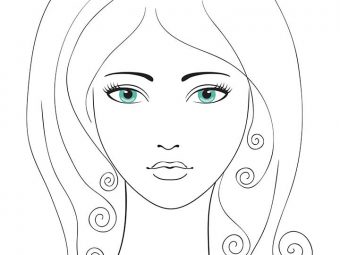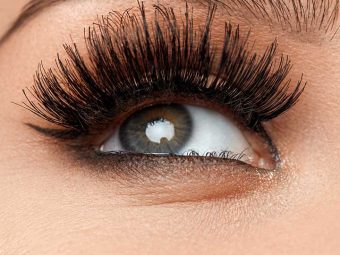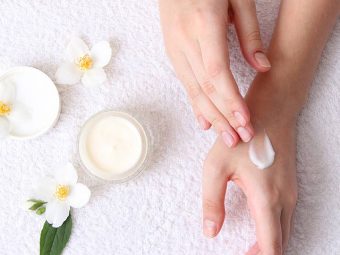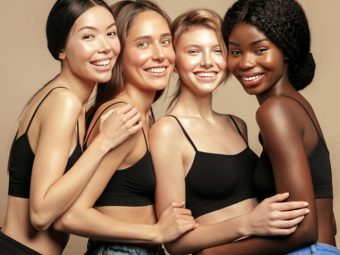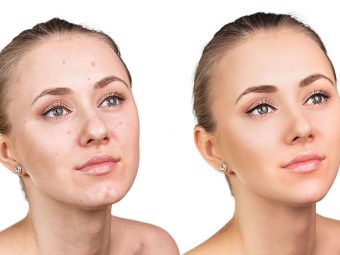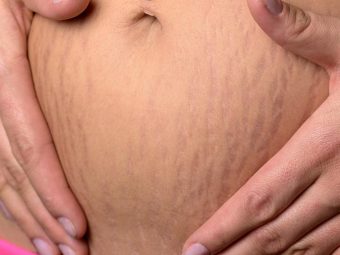10 Simple & Easy Steps For Perfect Eyebrow Threading At Home
Now get those well-groomed brows without pain and from the comfort of your home.

Image: Shutterstock
Perfectly shaped eyebrows can transform your face and highlight your eyes. But not everyone can visit a parlor whenever these brows grow out of shape. So, if you know how to thread eyebrows at home, it will not be a matter of concern at all. Eyebrow threading is the most common hair removal technique used to shape your brows. Though people visit a brow bar to get it done, you can always do it from the comfort of your own home. It is one of the easiest and quickest ways to remove your hair. This article discusses how to thread your eyebrows at home and more. Keep reading!
 Did You Know?
Did You Know?In This Article
All About Eyebrow Threading
What Is Eyebrow Threading?
Threading is an ancient hair removal method with temporary results. It is popularly used to remove facial hair from areas such as the eyebrows, around the lips, cheeks, and chin. The technique incorporates the use of cotton threads that are twisted and used to pull the hair from the root, much like waxing and tweezing. However, the results from threading are sharper and more defined. This technique can remove fine and short hair for cleaner results.
Is Eyebrow Threading Safe?
Not only is eyebrow threading much more efficient than tweezing or waxing, but it is also much safer. It removes the hair from the root without pulling at your skin too much. Although threading can be as painful as waxing, it is quick and gives you symmetrical and long-lasting results. Tweezing is time consuming, and waxing can leave the fragile skin around your eyebrows feeling sore for an entire day. This is why threading is a safer and superior alternative.
How To Thread Eyebrows At Home
You Will Need
- A 14-inch piece of high-cotton sewing thread
- A pair of eyebrow scissors
- Eyebrow brush
- Eyebrow pencil
- Aloe vera gel/Ice pack
Step 1 – Find A Mirror
Get all your supplies together and stand in front of a mirror in a well-lit room. Position yourself so that you can clearly see your eyebrows.
- Do not use a magnifying mirror as it is easy to over thread when using one.
Step 2 – Draw An Outline
Once you are done with trimming your brows, you need to draw out an outline of the shape you want. The best way to outline brows is using a soft lead brow pencil a shade darker than your natural brow hair color. Starting from the inside of your brow, draw the outline in an outward sweeping motion. This is a crucial step and must not be skipped, especially if you are threading your eyebrows for the first time.
- Take both the natural shape of your eyebrows and the shape you want into consideration when drawing the outline. For example, if you have thin brows, it is ideal to draw out a thinner arch.
Step 3 – Prep Your Brows
Using an eyebrow brush, sweep your eyebrow hair upwards. Hold the section in place with the brush and use a pair of eyebrow scissors to trim the end of the longer hairs. After this, comb the hair downwards and repeat the trimming process with any long hairs that might stick out from underneath the brush.
- Ensure that you do not over trim while doing this. Once you are done with trimming both your eyebrows, brush the hair back in place. Your eyebrows should look slightly groomed and clean.
- Trimming helps in grooming your bushy eyebrows and gives them a neater, fuller look while shortening longer strands so that it is easier for you to thread.
Step 4 – Prepare Your Thread
Take your piece of threading thread and tie its two ends to form a loop. Ensure that the knot is tight and trim off the loose ends so that you have a clean loop.
Step 5 – Twist Your Thread
Hold one side of the loop open with your thumb and forefinger and place your other thumb and forefinger in between the thread on the other side. Use one hand to twist the thread about 4-5 times while keeping your other hand still.
- After twisting the loop, you should have a twisted section in the middle.
Step 6 – Practice The Movement
Opening and closing the distance between your thumb and forefinger on each side of the twisted section will help move it from side to side. Open one hand while you close the other to move the twist.
- Keep practicing this motion until you get the hang of the threading technique and are confident.
- If you have some difficulty with this, try shortening the thread a little and try again. You can also do your eyebrow shaping by using your middle and ring fingers if you find it more comfortable.
Cosmetologist, Tiara Mckenzie shares a tip, “The eye area is sensitive so practicing on your thigh area is a great way to test the pressure you should use while threading. The hairs on our legs are fine and thin like our brow hairs. Always grab fresh threads when testing different methods.”
Step 7 – Positioning The Thread
For greater precision, start by positioning the twisted center of the thread over your eyebrow right on top of the hairs you want to remove.
Step 8 – Start Threading
Close the hand that is in control of the twisted center while you open the other. Slide the twist across your skin in a slow but firm motion. The corners of the twist will help grab and remove your hair as it moves.
- The twist must always move in the direction opposite to that of your hair growth, which is usually going inwards towards the nose or in a slightly upward direction away from the nose.
- Be gentle while you thread your eyebrows. You do not want to be too harsh or tug on your skin as this can be painful.
Step 9 – Shape Your Brows
Once you’re done with your first stroke, reposition the twist onto a new section of hair that you want to remove. Repeat this process and continue until you have achieved your desired shape.
- Once you get the hand of this, you will be able to tackle larger sections of hair in one stroke.
- Do not forget to thread in between your eyebrows.
Step 10 – After Care
Once you are done with threading your brows, you will notice a little redness and your skin might feel a bit sore. To help remedy this, and to prevent infection, apply some aloe vera or an ice-pack wrapped in cloth to your brows.
- Examine your eyebrows after a couple of hours to see if there are any stray hairs that you missed.
Before And After
Eyebrow Threading Shapes
It is important to take the shape of your face into consideration when deciding on how to shape your eyebrows. Even the most gorgeously groomed pair of brows can look unflattering when paired with the wrong face shape. To gain some insight on threading shapes or how you should shape your brows to complement your face, look at the guide below.
- Oval Shaped Face
Count yourself lucky if you have an oval face as it is almost impossible to go wrong while deciding on a style. This is because most eyebrow shapes complement an oval face. If you want to play it safe, maintain medium thick eyebrows with a soft angle, it will also help your brows have a more natural look.
- Long Shaped Face
With long faces, the goal is to minimize the length of your face. The best way to achieve this is to have flat brows with a slight curve where the arch is supposed to be. Flatter brows help distract from the length of your face, perfectly complementing an oblong face.
- Round Shaped Face
If you have a round face, the trick is to make your eyebrows look sharp to balance out your soft features. Your eyebrows should be shaped with high and sharp arches. This will help cut the fullness of a round face and will even create the illusion of length.
- Square Shaped Face
With a square-shaped face, you need to work to balance out the sharpness of the features while adding the illusion of length. This can be achieved by shaping your eyebrows in a way that they are high but have a soft curve instead of sharp arches.
- Heart Shaped Face
When working with a heart-shaped face, the goal is to distract attention from the strong pointy chin. This can be achieved by keeping the curves soft. The arch should be kept low and full to add the appearance of length to your forehead.
- Diamond Shaped Face
If you have a diamond-shaped face, you must keep in mind that the brow and temple region of your face is the widest. The goal is to balance this out and create softness to counter the sharp features. For this, you need to create defined brows but with a full curve to reduce the appearance of width, while softening your features.
You can also consult your aesthetician to get a deeper understanding of what brow shape, arch height, eyebrow length and thickness would suit your face.
 Did You Know?
Did You Know?Benefits Of Eyebrow Threading
Over the years, eyebrow threading has gained worldwide popularity due to its multiple benefits. These include:
- Precision: Threading offers exceptional accuracy in shaping eyebrows, targeting individual hairs to ensure perfectly sculpted brows.
- Less Skin Damage: Unlike waxing, threading doesn’t tug on the skin. This reduces the risk of skin sagging over time.
- Hygienic Process: If done properly with a fresh thread, the method minimizes the risk of skin infections.
- Minimal Chemical Exposure: Threading doesn’t involve any chemicals, making it ideal for sensitive skin and reducing allergic reactions.
- Long-lasting Results: Results can last up to 6 weeks, depending on individual hair growth rates.
- Suitability: It’s suitable for all skin types, even those with thin or sensitive skin.
- Quick Process: With a skilled practitioner, threading is swift, often taking just a few minutes.
Alexandra, a YouTuber, shared a tutorial on how to thread facial hair at home. She said, “What I realized is that waxing doesn’t remove every single hair so that’s why I like to thread, it removes the pigmentation that I don’t like. Now my skin is feeling fresh and it’s definitely ready to go (i).”
Keep reading for some threading tips to reduce any discomfort that may be associated with threading!
Additional Eyebrow Threading Tips
- Steam your face or shower in hot water before you thread your eyebrows. This will help soften your hair and open your pores so that it is easier to remove hair.
- If you are extremely sensitive to pain, use a drugstore anesthetic cream or teething gel a few minutes before starting to numb the area.
- Dust on some talc onto the brow region before threading. This helps with the gripping during the process.
 Quick Tip
Quick TipInfographic: Steps To Follow Before Threading Eyebrows At Home
Eyebrow threading is the most popular hair removal procedure to shape your brows. While many beauty salons provide these threading services, you can also do it from the comfort of your home. Threading your eyebrows is also considerably safer on sensitive skin, and many people like it because it removes a clean line of hair at a time rather than individual hair, making it a little faster. Follow the guide on threading eyebrows at home, and once you get the hang of it, you will notice that it is not difficult to perform this eyebrow beauty treatment from the comfort of your home. Illustration: StyleCraze Design Team
Save the high-quality PDF version on your device now.
Download Infographic
Eyebrow threading is the most popular hair removal procedure to shape your brows. While many beauty salons provide this service, you can also do it from the comfort of your home if you know how to thread eyebrows. Threading your eyebrows is also considerably safer on sensitive skin, and many people like it because it removes a clean line of hair at a time rather than individual hair, making it a little faster. Follow the guide on threading eyebrows at home, and once you get the hang of it, you will notice that it is not difficult to perform at home.
Frequently Asked Questions
How long does eyebrow threading take?
Depending on your speed, eyebrow threading can take anywhere between 3-7 minutes.
Is eyebrow threading painful?
Eyebrow threading can be as painful as waxing, especially if it is your first time doing it. However, your hair grows out thinner after threading, making it less painful the next time.
How to make threaded eyebrows last longer?
Threaded eyebrows take about 6-10 weeks to grow back. You can extend this by going in with tweezers or re-threading everytime you start to notice stray hairs growing back.
What to do after threading your eyebrows?
You may experience some redness and soreness after you thread your eyebrows, use aloe vera gel or an ice pack to soothe this.
How to shape your eyebrows without threading?
Waxing, tweezing, and shaving are some of the popular alternatives to threading your eyebrows. However, although painful, threading is one of the most efficient ways to shape your brows.
Is it better to thread or pluck eyebrows?
Threading is increasingly becoming more popular than plucking to get shapely brows. Threading removes the hair along with the root follicles, and lasts longer than plucking. Plucking, if done right, can also get hairs out by the root, though it may also break off the hair strands. Additionally, threading takes comparatively less time than plucking.
Do eyebrows grow back thicker after threading?
No. Eyebrows won’t grow back thicker after threading. On the contrary, your eyebrows can get thinner or finer after prolonged threading as repeatedly pulling the hair out from the roots may damage the follicles. This process also makes eyebrow maintenance easier.
How often should you thread your eyebrows?
Usually, eyebrows take between 2 to 6 weeks to fully grow back. You can choose your threading frequency based on that. You also can consider the growth rate of your eyebrows and how clean you want them to look on a regular basis.
Why do I get bumps after threading?
Bumps may appear as the threading process can irritate the skin. Hence, apply ice, cold compress, or a soothing gel on the eyebrows immediately after threading to minimize the appearance of bumps.
Perfectly groomed brows don’t have to be so elusive. Although threading might seem quite tricky to figure out, it is one of the most efficient methods for shaping your eyebrows. Have you ever threaded your brows? Tell us about your experience in the comments section below.
Key Takeaways
- Eyebrow threading is a widely known hair removal technique that uses cotton threads to twist and pull the hair from the root to shape the brows.
- Threading at home is less expensive, but mastering the skill takes time and effort.
- A cotton thread, mirror, eyebrow scissors, eyebrow brush and pencil, and decent lighting are all you need.
- Apply a lotion or aloe vera gel after threading to lessen redness and avoid infection.
- Since an incorrect method can result in irritation, infection, or uneven outcomes, practice the process with caution.
Curious about eyebrow threading? Get up close and personal in this detailed video that reveals the art of shaping brows. Watch now to witness the transformation!
Personal Experience: Source
(i) How I Thread My Face (REQUESTED)
https://www.youtube.com/watch?v=TDfwnwSgN6I





















